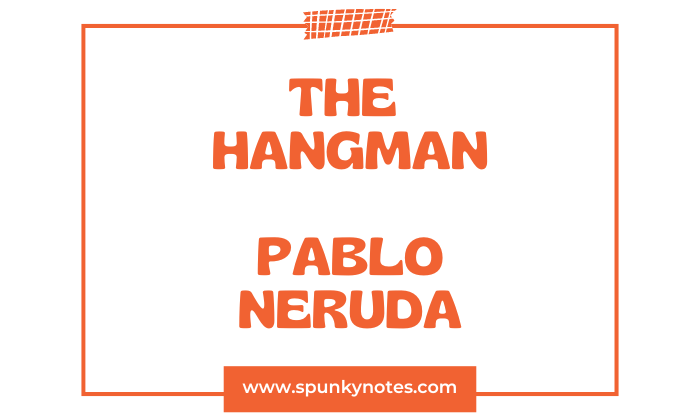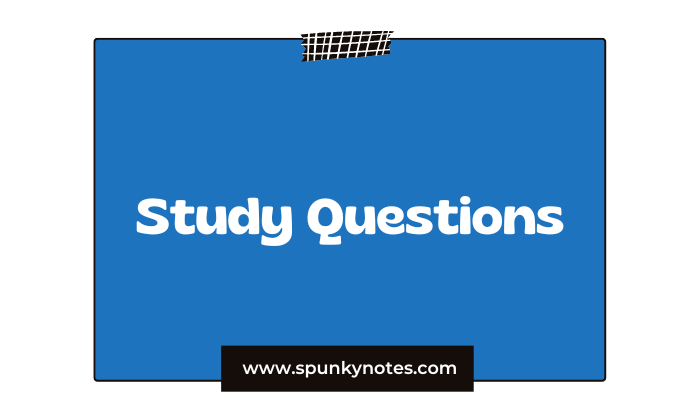
Q. Explain the poem The Hangman by Pablo Neruda.
“Canto General” is a sweeping epic poem by Chilean poet Pablo Neruda. Published in 1950, it is considered one of Neruda’s most significant works and a masterpiece of Latin American literature.
Canto General is divided into 15 sections (canto) across two volumes and contains over 300 poems.
- La lámpara en la tierra (The Lamp on Earth)
Contains “Amor América (1400)” (Love America). - Las alturas de Macchu Picchu (The Heights of Macchu Picchu)
- Los conquistadores (The Conquistadors)
- Los libertadores (The Liberators)
- La arena traicionada (The Sand Betrayed)
Contains “The Hangman” (El verdugo). - América, no invoco tu nombre en vano (America, I Do Not Invoke Your Name in Vain)
- El estrecho dudoso (The Uncertain Strait)
- Canto general de Chile (General Song of Chile)
- La tierra se llama Juan (The Earth is Called Juan)
- Que despierte el leñador (Let the Woodcutter Awaken)
- Las flores de Punitaqui (The Flowers of Punitaqui)
- Los ríos del canto (The Rivers of Song)
- Coral de año nuevo para la patria en tinieblas (New Year’s Song of the Nation in Darkness)
Contains “You Will Fight” (Lucharás) as the 16th poem. - El gran océano (The Great Ocean)
- Yo soy (I Am)
The Hangman
Saurian, scaly America coiled
Around vegetable growth, around the flagpole
erected in the swamp:
You nursed terrible children
With poisonous serpent’s milk,
torrid cradles incubated
And covered a bloodthirsty
Progeny with yellow clay.
The cat and scorpion fornicated in the savage land.
The hangman
The light fled from branch to branch,
But slumbering man did not awaken.
The blanket smelled of sugarcane,
Machetes had rolled into
The surliest siest site,
And in the cantinas’ rarefied crest
The shoeless day laborer
Spouted his boastful independence.
Explanation of The Hangman by Pablo Neruda
Saurian, scaly America coiled
“Saurian” means reptiles like lizards and dinosaurs, which symbolize ancient and possibly dangerous forces. Neruda suggests that America has old, entrenched, and possibly harmful traits.
“Coiled” means ready to strike, implying hidden danger or defensiveness, possibly against change or reform. From a postcolonial view, it symbolizes the lasting power structures left by colonialism.
With poisonous serpent’s milk
This contradicts the danger of serpents with the nurturing aspect of milk. Milk, usually life-giving, is deadly when described as a “poisonous serpent.”
It suggests that the nation’s ideological foundation is toxic, corrupting those raised within its system. Postcolonially, this represents the harmful ideas left by colonizers that continue to damage society.
Torrid cradles incubated
“Torrid” means very hot and uncomfortable, suggesting a harsh environment. “Cradles” are typically safe places for infants, but “torrid cradles” imply that new life or ideas start in tough conditions.
This reflects the postcolonial reality of emerging nations growing under the harsh legacy of colonial oppression.
Covered a bloodthirsty
Progeny with yellow clay
“Bloodthirsty Progeny” refers to a new generation eager for conflict. “Covering” them with “yellow clay” suggests hiding their true nature. Yellow clay might symbolize a facade of cowardice or decay, implying that their violent nature is masked.
This denotes the hidden aggressions of neocolonial powers and local elites who disguise their exploitative actions as progress.
The cat and scorpion fornicated in the savage land
This line suggests a dangerous and unnatural union. Cats and scorpions are predatory, and their union in a “savage land” (a term with colonial connotations of untamed territory) implies the breeding of harmful elements.
This reflects postcolonial themes of unnatural alliances formed during and after colonial rule, leading to complex social and political consequences.
The light fled from branch to branch
Light symbolizes knowledge and hope. The idea of light “fleeing” suggests that understanding is present but elusive, constantly moving, and never fully graspable.
It shows the elusive nature of true independence and self-realization in nations still dealing with their colonial pasts.
The blanket smelled of sugarcane
Machetes had rolled into the surliest siesta site
Machetes are tools associated with labor and violence. “Rolled into the surliest siesta site” evokes images of these tools being put aside during a bad-tempered rest period, suggesting latent hostility even during rest.
This reflects the ongoing struggles and discontent in postcolonial societies, where tools of labor and resistance remain present even in moments of rest.
And in the cantinas’ rarefied crest,
The shoeless day laborer spouted his boastful independence.
The “cantinas’ rarefied crest” suggests a place of elevated but perhaps superficial thoughts. A “shoeless day laborer” represents the poor working class who, despite their circumstances, proclaim their independence.
It highlights the irony of perceived freedom contrasted with actual socio-economic conditions, critiquing the superficial political independence that doesn’t translate into true liberation for the masses.
Explanation from a Postcolonial Perspective
America as a Saurian, scaly
Neruda’s depiction of America as an ancient reptilian creature symbolizes deeply entrenched colonial structures and ideologies. These colonial legacies are pervasive and enduring, influencing the sociopolitical landscape long after the colonizers have left.
Toxic Nurturing
The poem describes the continent as nurturing its children with “poisonous serpent’s milk.” This suggests destructive ideologies and practices from the colonial era that still affect post-colonial societies.
This imagery shows the damaging impact of colonialism on cultural and societal norms, perpetuating violence and oppression.
Hybridity and Unnatural Unions
The line “The cat and scorpion fornicated in the savage land” illustrates the theme of hybridity in postcolonial theory. It refers to new cultural identities formed from the blending of colonizer and colonized.
This union also represents forced assimilations and cultural disruptions from colonial rule, leading to a society with conflicts and contradictions.
Passivity and Resistance
“The light fled from branch to branch, but the slumbering man did not awaken” highlights the passivity of the colonized peoples. It suggests a lack of awareness or refusal to acknowledge colonialism’s impacts.
The poem calls for an awakening, urging the oppressed to recognize and resist their subjugation.
Economic Exploitation
The imagery of the blanket smelling of sugarcane and machetes lying idle represents the economic exploitation typical of colonial and neocolonial practices.
It shows how local resources are harvested to benefit others outside the laboring community. The mention of sugarcane underscores ongoing economic disparities rooted in colonial exploitation.
Irony of Independence
The lines about the shoeless day laborer boasting of his independence in a cantina highlight post-colonial independence’s ironic and often superficial nature.
It critiques the illusion of freedom and autonomy when economic and social inequalities still bind the once colonized to their colonial pasts.
